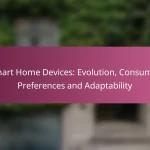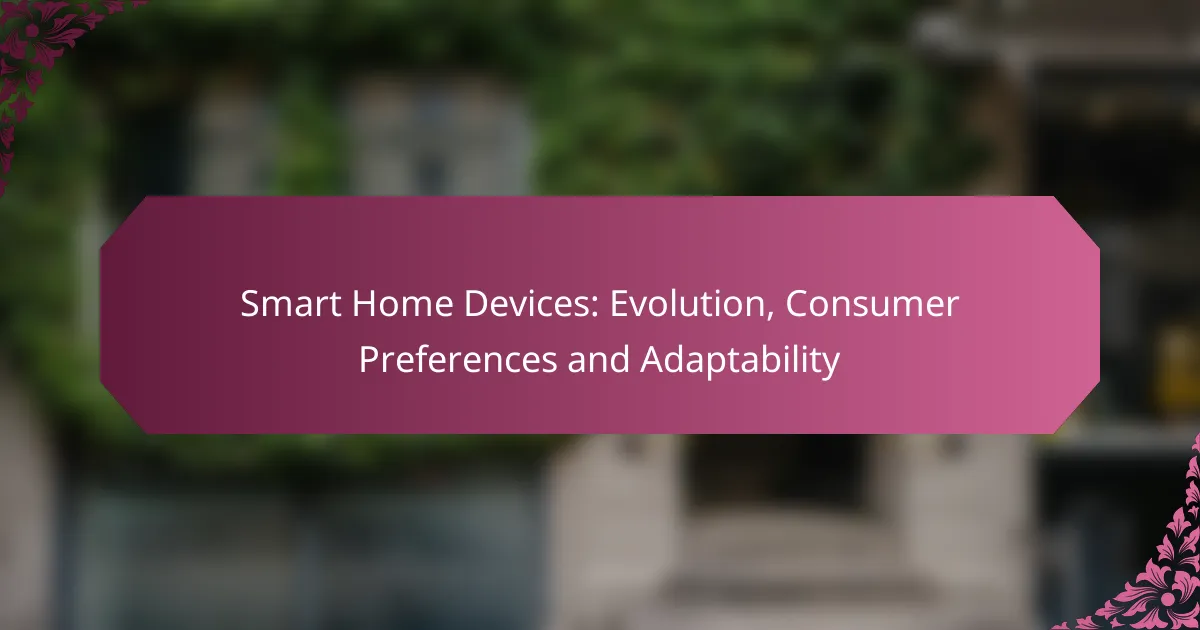Smart home devices have evolved from simple remote controls to advanced systems that enhance convenience, security, and energy efficiency in daily life. Driven by technological innovations and consumer demand, these devices now offer features like voice control and seamless integration, catering to a variety of lifestyles. As consumers prioritize ease of use, compatibility, and security, these preferences shape the market and influence purchasing decisions.
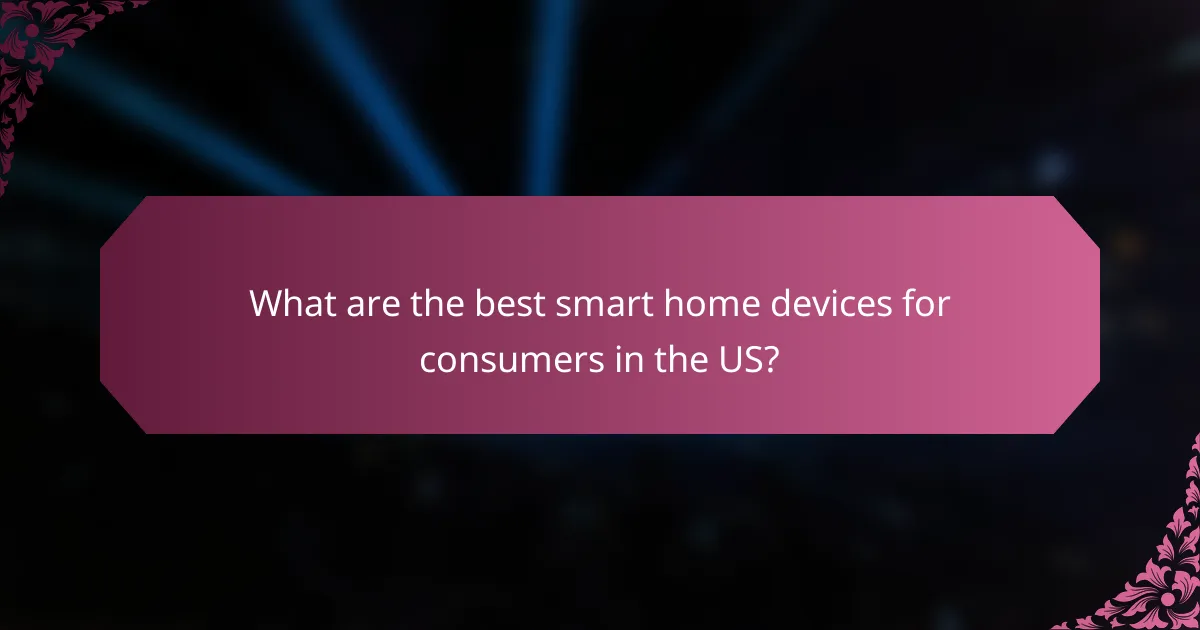
What are the best smart home devices for consumers in the US?
The best smart home devices for consumers in the US include a range of products that enhance convenience, security, and energy efficiency. Popular choices often feature voice control, smart integration, and user-friendly interfaces, making them accessible for various lifestyles.
Amazon Echo Dot
The Amazon Echo Dot is a compact smart speaker that utilizes Alexa for voice commands. It allows users to control other smart devices, play music, set reminders, and access information hands-free.
When considering the Echo Dot, think about its compatibility with other smart home devices, as it works seamlessly with a wide range of brands. The device is typically priced in the low $50 range, making it an affordable entry point into smart home technology.
Google Nest Hub
The Google Nest Hub is a smart display that combines a touchscreen with Google Assistant capabilities. Users can control smart devices, view photos, and watch videos, all while receiving visual feedback on their commands.
With a price point around $100, the Nest Hub offers a versatile experience, especially for those who prefer visual interfaces. Its ability to integrate with Google services enhances functionality, making it a strong choice for Google ecosystem users.
Philips Hue Smart Bulbs
Philips Hue Smart Bulbs are energy-efficient LED lights that can be controlled remotely via a smartphone app or voice commands. They offer a wide range of colors and brightness levels, allowing users to customize their lighting experience.
These bulbs typically range from $15 to $50 each, depending on the model and features. Consider starting with a starter kit that includes a hub for easier control and integration with other smart devices.
Ring Video Doorbell
The Ring Video Doorbell enhances home security by allowing users to see and communicate with visitors at their door via a smartphone app. It features motion detection and video recording capabilities, providing peace of mind for homeowners.
Prices for the Ring Video Doorbell generally start around $100, with additional costs for subscription services that offer cloud storage for video footage. Ensure your Wi-Fi signal is strong at the door location for optimal performance.
Ecobee Smart Thermostat
The Ecobee Smart Thermostat offers advanced temperature control and energy savings by learning user preferences and adjusting settings accordingly. It can be controlled remotely through an app and integrates with various smart home systems.
Typically priced between $150 and $250, the Ecobee can significantly reduce energy bills by optimizing heating and cooling schedules. Consider models with built-in sensors for better temperature management throughout your home.

How have smart home devices evolved over the years?
Smart home devices have significantly advanced from basic remote-controlled gadgets to sophisticated systems that integrate seamlessly into daily life. This evolution has been driven by technological innovations, consumer demand for convenience, and the growing importance of energy efficiency.
Introduction of voice assistants
The introduction of voice assistants, such as Amazon’s Alexa and Google Assistant, marked a pivotal shift in how users interact with smart home devices. These assistants allow for hands-free control, enabling users to issue commands using natural language, which simplifies device management.
Voice assistants can control various smart devices, from lighting to thermostats, making them central to many smart home ecosystems. This integration enhances user experience by providing a more intuitive way to manage home environments.
Integration with IoT technology
Smart home devices have increasingly integrated with Internet of Things (IoT) technology, allowing for real-time data exchange and remote monitoring. This connectivity enables devices to communicate with each other, creating a cohesive smart home network.
For example, a smart thermostat can adjust heating based on data received from smart sensors detecting occupancy. This not only improves comfort but also optimizes energy usage, leading to potential savings on utility bills.
Rise of home automation systems
The rise of home automation systems has transformed individual smart devices into interconnected solutions that enhance overall home functionality. These systems allow users to automate routines, such as scheduling lights to turn on at sunset or adjusting the thermostat when leaving home.
Home automation can be tailored to fit various lifestyles, with options ranging from simple setups to complex configurations involving multiple devices. Users should consider compatibility and ease of use when selecting automation systems to ensure a smooth integration into their existing smart home setup.
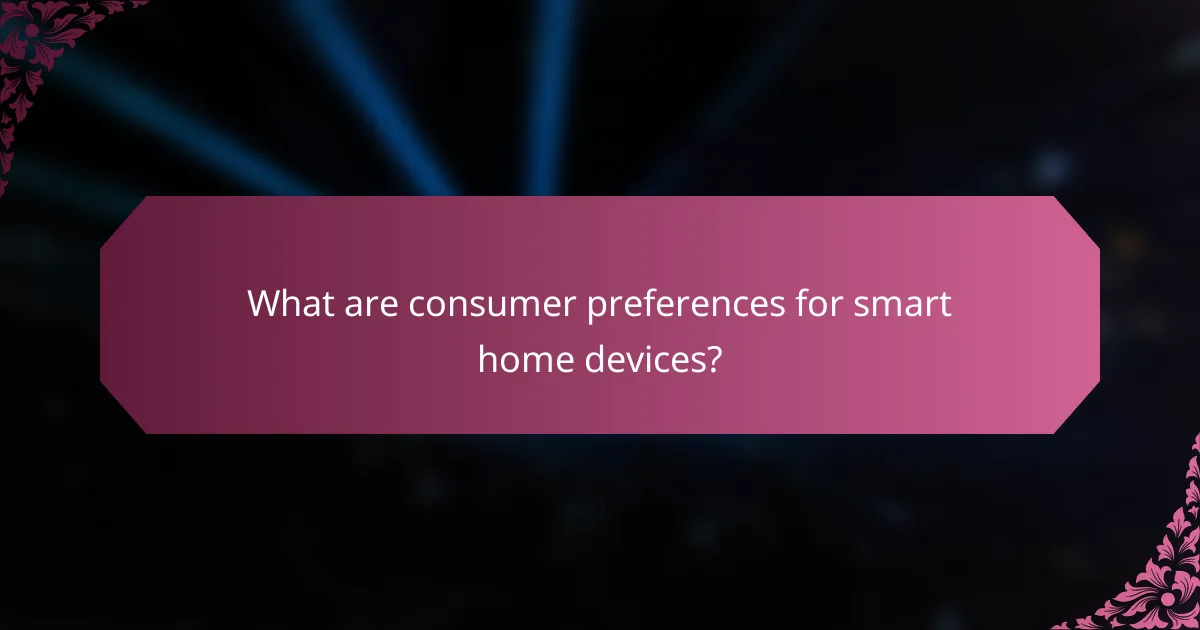
What are consumer preferences for smart home devices?
Consumer preferences for smart home devices focus on ease of use, compatibility with existing systems, and robust security features. These factors significantly influence purchasing decisions and overall satisfaction with smart home technology.
Ease of use
Ease of use is a primary concern for consumers when selecting smart home devices. Users prefer devices that are intuitive and require minimal setup, allowing for quick integration into daily routines. A straightforward mobile app interface and voice control capabilities enhance usability.
For example, devices that can be controlled via a single app or through voice commands with popular assistants like Amazon Alexa or Google Assistant are often favored. Consumers should look for devices with user-friendly installation guides and responsive customer support.
Compatibility with existing systems
Compatibility with existing systems is crucial for seamless integration of smart home devices. Consumers typically seek devices that can easily connect with their current home automation systems, such as smart hubs or other connected devices. This ensures a cohesive smart home experience without the need for extensive reconfiguration.
When considering new devices, check for compatibility with popular standards like Zigbee or Z-Wave, which enhance interoperability among various brands. A device that works well with existing ecosystems, such as Apple HomeKit or Samsung SmartThings, can save time and reduce frustration.
Security features
Security features are a top priority for consumers concerned about privacy and data protection in their smart homes. Devices equipped with strong encryption, regular firmware updates, and secure authentication methods are more appealing to buyers. Consumers should prioritize brands that demonstrate a commitment to security.
Additionally, features like two-factor authentication and the ability to monitor device activity can provide peace of mind. It’s advisable to read reviews and check for any reported vulnerabilities before making a purchase, ensuring that the chosen devices meet high-security standards.
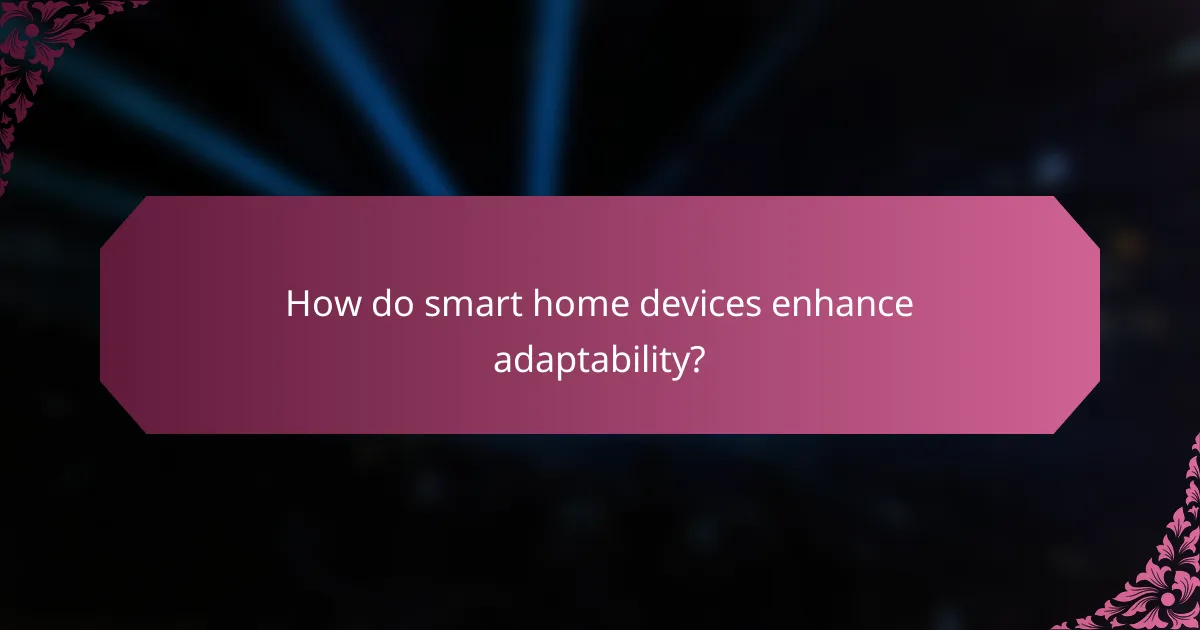
How do smart home devices enhance adaptability?
Smart home devices enhance adaptability by allowing users to tailor their environments to meet specific needs and preferences. This flexibility is achieved through various features that enable customization, learning, and remote management.
Customization options
Customization options in smart home devices allow users to set preferences for lighting, temperature, and security settings. For example, smart thermostats can be programmed to adjust heating or cooling based on the time of day or occupancy, creating a comfortable environment while saving energy.
Many devices offer user-friendly interfaces or apps that enable easy adjustments. Users can create schedules or scenes that automate multiple devices simultaneously, such as dimming lights and locking doors at bedtime.
Learning algorithms
Learning algorithms in smart home devices analyze user behavior to optimize performance over time. For instance, a smart thermostat can learn when a household is typically occupied and adjust temperatures accordingly, improving comfort and efficiency.
These algorithms often utilize machine learning techniques to adapt to changing patterns, making the system more intuitive. Users benefit from reduced manual adjustments as the device becomes more aligned with their routines.
Remote access capabilities
Remote access capabilities enable users to control their smart home devices from anywhere using smartphones or tablets. This feature is particularly useful for monitoring security cameras or adjusting heating while away from home.
Many devices support notifications and alerts, allowing users to respond quickly to unusual activity or changes in their home environment. Ensuring a secure internet connection is essential for safe remote access, so users should consider using strong passwords and enabling two-factor authentication where available.
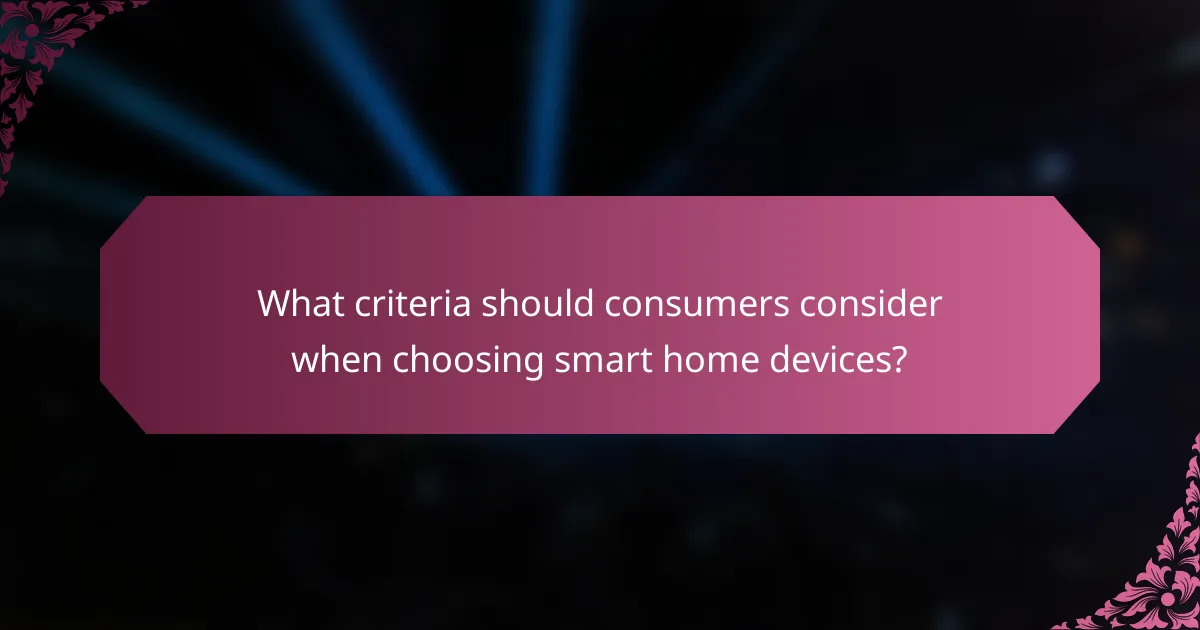
What criteria should consumers consider when choosing smart home devices?
Consumers should evaluate compatibility, functionality, security, and ease of use when selecting smart home devices. These criteria ensure that the devices work seamlessly together, meet specific needs, and provide a secure and user-friendly experience.
Compatibility with existing systems
Compatibility is crucial when choosing smart home devices, as it determines how well new devices will integrate with your current setup. Check whether the devices work with popular ecosystems like Amazon Alexa, Google Assistant, or Apple HomeKit. Ensuring compatibility can save time and reduce frustration during installation and operation.
Functionality and features
Consider the specific functionalities and features that each smart home device offers. Look for devices that provide automation, remote control, and monitoring capabilities. For example, smart thermostats can learn your schedule and adjust temperatures accordingly, while smart lights can be programmed for different moods or times of day.
Security and privacy
Security is a major concern with smart home devices, as they can be vulnerable to hacking. Choose devices that offer robust security features, such as encryption and regular software updates. Additionally, review the privacy policies of manufacturers to understand how your data will be used and protected.
Ease of installation and use
Ease of installation and user-friendliness are important factors to consider. Some devices require professional installation, while others can be set up in minutes. Look for user-friendly interfaces and mobile apps that simplify control and monitoring. Reading user reviews can provide insights into the installation process and overall usability.
Cost and value
Evaluate the cost of smart home devices against their features and benefits. While some devices may have a higher upfront cost, they can offer long-term savings through energy efficiency or enhanced security. Create a budget and prioritize which devices will deliver the most value based on your specific needs.


